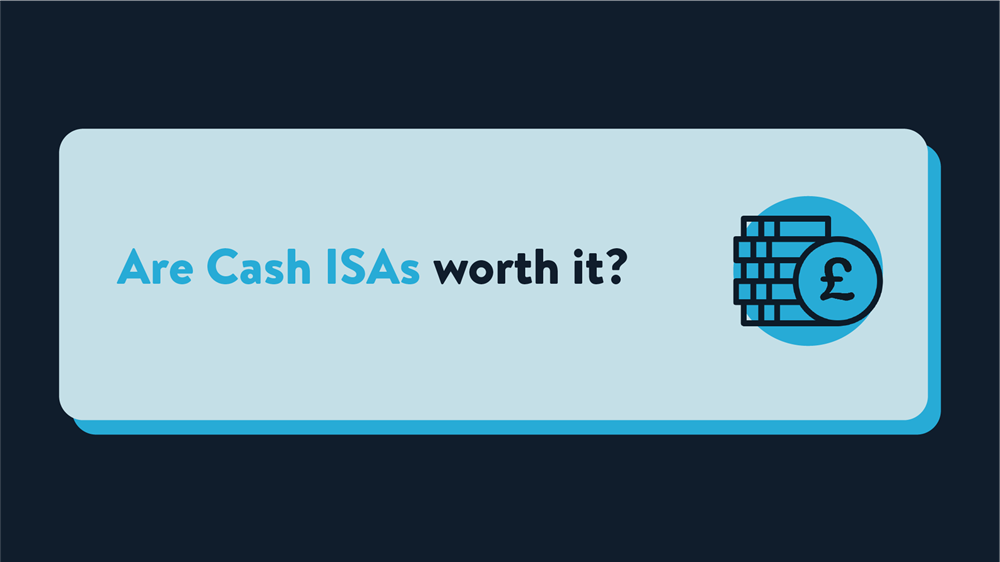With an estimated £300 billion deposited [1] and almost 8 million people using them each year [2], Cash ISAs are clearly a popular tool for savers in the UK.
But with recent discussions about the government potentially reducing the annual allowance from £20,000 to £4,000 [3] (a move which aims to encourage a US-style investing mentality), what benefits does a Cash ISA have versus the other opportunities out there? Well, in this article, we’re going to explore just that, starting with the simple question: are Cash ISAs still worth having?
- Are Cash ISAs Worth having?
- Potential drawbacks of a Cash ISA
- Are Cash ISAs safe?
- Should you put all your money in a Cash ISA?
- What are the other types of ISAs available?
- Summary
Are Cash ISAs worth having?
Cash ISAs have been around since the inception of the Individual Savings Account (ISA) launch in 1999. And, whether you want to build up an emergency fund or save for the future, they’re worth having for several reasons. Here are some of the main ones:
- Tax-free: Whether you save £200 of your annual ISA allowance or the full £20,000, there's no tax to pay on any interest you earn from a Cash ISA.
- Stability: Unlike a Stocks and Shares ISA (which is affected by the ups and downs of stock markets), Cash ISAs offer specific interest rates — and, as a result, more stable returns.
- Variety: From fixed to variable interest rates, easy access to notice accounts; you can choose from a range of Cash ISAs to suit your individual needs.
- Access: With easy access Cash ISAs, you can access your money anytime, with no fees.
- Flexibility: You’re free to open as many Cash ISAs as you want, with specific flexible Cash ISAs letting you withdraw and deposit money without affecting your allowance.
Just as an FYI, Wealthify’s Cash ISA is both flexible and easy access.
Drawbacks of a Cash ISA
Depending on your circumstances, some of the benefits of a Cash ISA could also be seen as drawbacks.
If you’re looking to invest more than £20,000 during the tax year, for example, then a Cash ISA’s annual allowance might not meet your needs.
To enjoy real growth, your savings will also need to grow at least at the same pace as everything else. In other words: the interest rate you get should be at least equal to the rate of inflation.
Every time it goes under, your savings will effectively grow slower than your living costs, and over time, your purchasing power could go down.
So, if you’re pursuing long-term growth, the variable or fixed interest rates of a Cash ISA might not provide the returns you’re looking for.
Are Cash ISAs safe?
Yes, they are.
In fact, Cash ISAs are safe in two senses.
Firstly, because they offer your money specific interest rates and more predictable returns.
Secondly, they’re protected by the Financial Services Compensation Scheme (FSCS), meaning up to £120,000 is protected per person, per regulated firm.
Should you put all your money in a Cash ISA?
How much you put in a Cash ISA is completely up to you — and will generally depend on your financial situation and personal circumstances. But before you make your decision, it’s important to understand how Cash ISAs work over the long-term.
As previously mentioned, paying into a Cash ISA is a great way to give your money a tax-efficient boost. However, this doesn’t account for the potential impact of inflation on your savings.
Obviously, we’re not telling you to ignore Cash ISAs; after all, they’re a really useful way to build a nest egg or emergency fund.
But when it comes to deciding how much money you want to put in one, it could be a good idea to consider other options better suited to your goals. If you’re after inflation-beating numbers, for example, you could consider investing in a Stocks and Shares ISA, which grows based on stock market performance.
Although, as with all investments, your capital is at risk. It’s important to remember that the value of your money can go down as well as up, and you could get back less than what you put in.
What are the other types of ISAs available?
Before deciding whether a Cash ISA is right for you, it’s important to consider – and understand – the three other types of adult ISAs on offer:
- Stocks and Shares ISA (aka Investment ISA)
- Innovative ISA
- Lifetime ISA (which has a £4,000 allowance)
Even though all four ISAs offer different options and benefits, you can split your annual £20,000 allowance between them.
Stocks and Shares ISA
A Stocks and Shares ISA lets you invest your money in the stock market, where you can purchase things like shares, investment funds, and bonds. You can do this yourself — or get an online investment platform like Wealthify to do it for you.
Requiring patience and a long-term outlook, a Stocks and Shares ISA could provide better returns than a Cash ISA; however, there is more risk with investing, because the value of your money can go down as well as up.
A Stocks and Shares ISA isn’t for everyone, which is why, when you apply for a Wealthify Investment Plan, you’re asked a few suitability questions to make sure that investing is for you.
For more information, read our definitive guide to Stocks and Shares ISAs.
Innovative Finance ISA
Launched in April 2016, you can invest your full £20,000 allowance in an Innovative Finance ISA (aka IFISA), which lets you make peer-to-peer (P2P) lending investments. P2P lending platforms connect people who’d like to invest money, with prospective borrowers looking for a loan.
You can decide upfront how much and how long you want to, with P2P platforms matching you with a borrower that suits your terms.
The platform will manage the process for you and, once you’ve been matched with a borrower and the money is lent, you’ll start to earn interest. Depending on the platform you use, you could either take the interest as income, or reinvest it in your IFISA to try and maximise your returns.
Lifetime ISA
This type of ISA can only be opened by those aged between 18 and 39, and contributions can only be made up until the age of 50.
You can only invest up to £4,000 each tax year in a Lifetime ISA, but you could earn up to £1,000 each year to boost your savings, as the government will top it up with 25%. Although you can only have one Lifetime ISA, it can be a combination of a Cash Lifetime ISA and Stocks and Shares Lifetime ISA — as long as it's within the £4,000 allowance.
Money held in a Lifetime ISA must be used to either buy your first property. Or, if you’re already a homeowner, you’ll need to wait until you’re 60 and use it to boost your retirement fund.
Summary
So, are Cash ISAs worth it?
Well, thanks to its tax efficiency, stability, variety, accessibility, and flexibility — we think the answer is a resounding ‘yes’!
Before opening a Cash ISA, however, always do as much research as possible, comparing it to the other types of ISAs to ensure it meets your needs.
When choosing an ISA, it’s also worth remembering that it’s not a one-or-the-other kind of decision; as long as you stick to your annual allowance, you can have multiple types of ISAs (apart from just the one Lifetime ISA).
So, if you’ve made it this far and think you might want to open one with Wealthify, head to Wealthify’s Cash ISA page to learn more!
Please remember the value of your investments can go down as well as up, and you could get back less than invested.
The tax treatment depends on your individual circumstances and may be subject to change in the future.
Wealthify does not provide financial advice. Seek financial advice if you are unsure about investing.
References:
- https://www.independent.co.uk/money/cash-isa-limits-allowance-changes-rachel-reeves-b2700814.html
- https://www.theguardian.com/money/2025/mar/01/cash-isas-4000-allowance-tax-free-accounts-limit
- https://www.bbc.co.uk/news/articles/c9qjn879lr4o



